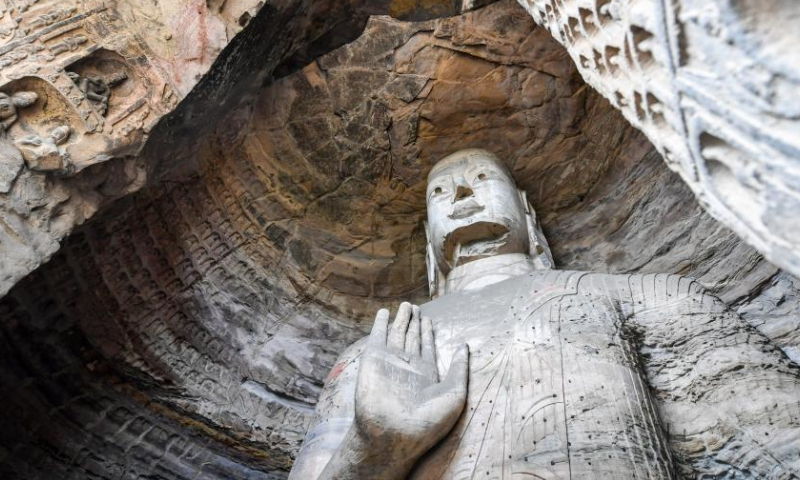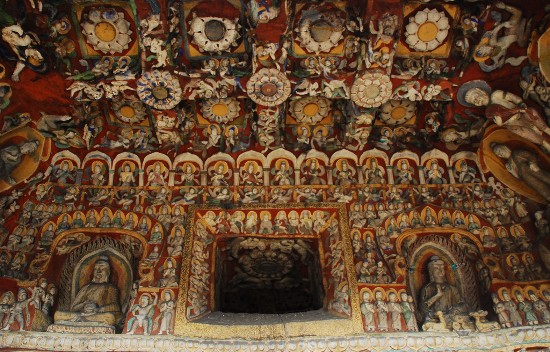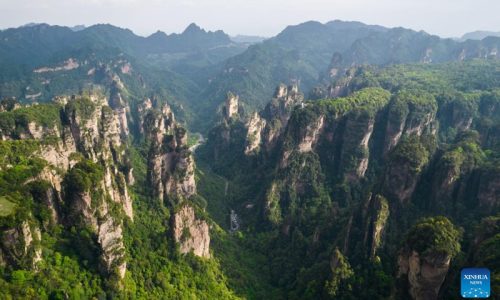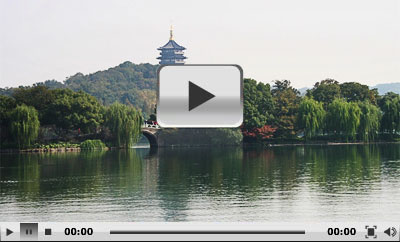Discover the Wonders of the Yungang Grottoes in Shanxi Province, China
Exploring the Yungang Grottoes in Shanxi Province, China offers a unique journey into ancient Chinese artistry and religious history. Located in Shanxi Province, these spectacular caves are renowned for their intricate carvings, majestic statues, and historical significance. The site, which dates back over a millennium, showcases the exquisite craftsmanship of early Buddhist artisans and reflects the rich cultural heritage of China. Visitors can marvel at the over 50,000 statues and numerous grotto chambers that depict stories from Buddhist scriptures, making it a must-visit destination for history enthusiasts and art lovers alike. The Yungang Grottoes in Shanxi Province, China stand as a testament to the spiritual and artistic achievements of ancient China, drawing millions of tourists annually who seek to experience its timeless beauty and profound history. Whether exploring the detailed stone carvings or learning about the site’s role in spreading Buddhism across East Asia, this UNESCO World Heritage site offers an unparalleled glimpse into China’s glorious past and its enduring cultural legacy.

Ancient and Fascinating History of Yungang Grottoes in Shanxi Province, China
The Yungang Grottoes in Shanxi Province, China, stand as one of the most significant cultural heritage sites, with a history spanning over a millennium. These majestic caves, carved into the cliffs, showcase an extraordinary blend of Buddhist art, architecture, and religious symbolism from the Northern Wei Dynasty. Their origins date back to the 5th century AD, making them a vital link to China’s ancient spiritual and artistic traditions. The site reflects the cultural exchanges along the Silk Road and highlights the profound influence of Buddhism on Chinese civilization. Over centuries, the Yungang Grottoes have witnessed numerous restorations and preservation efforts to maintain their historical integrity, serving as a testament to China’s rich cultural legacy. Recognized as a UNESCO World Heritage Site, they continue to attract scholars, tourists, and spiritual pilgrims worldwide. The intricate statues and murals narrate stories of Buddhist teachings, illustrating the spiritual journey of ancient China. Their significance extends beyond religion, representing a pinnacle of Chinese stone sculpture and artistic achievement. The site embodies the harmonious integration of religious devotion and artistic innovation, making it an invaluable cultural treasure of China and the world.
Architectural Marvels and Fine Arts of Yungang Grottoes in Shanxi Province, China
The Yungang Grottoes exemplify a remarkable achievement in Chinese rock-cut architecture and sculpture, featuring over 50,000 statues and numerous caves. The craftsmanship reflects a sophisticated understanding of stone carving techniques, blending traditional Chinese artistry with influences from Central Asia and India. The layout of the caves demonstrates advanced engineering, with intricate carvings, grand gateways, and detailed relief sculptures that depict Buddhist deities, guardians, and mythological scenes. Each sculpture is a masterpiece of detail, showcasing the skill of ancient artisans who meticulously crafted every figure with precision and spiritual intent. The use of natural rock formations as a canvas allowed for expansive murals and bas-reliefs, illustrating stories from Buddhist scriptures and local legends. The interior walls are adorned with vibrant paintings, utilizing mineral-based pigments that have withstood centuries of weathering. These artworks not only served religious purposes but also influenced subsequent Chinese art, inspiring dynasties to develop their own sculpture and mural traditions. The architectural harmony and artistic finesse of the Yungang Grottoes continue to influence Chinese religious art and stone sculpture, making them a pinnacle of cultural achievement in Shanxi Province, China.
Role of Yungang Grottoes in Promoting Buddhism in Shanxi Province, China
The Yungang Grottoes played a pivotal role in the dissemination and establishment of Buddhism in Shanxi Province and across China. Constructed during the Northern Wei Dynasty, they served as a religious center where monks, pilgrims, and scholars gathered to study Buddhist teachings. The statues and murals within the caves vividly depict the life of Buddha, bodhisattvas, and various Buddhist symbols, acting as visual sermons for devotees. These artworks facilitated the spread of Buddhist philosophy, making complex spiritual concepts accessible to the common people. The site also functioned as a pilgrimage destination, attracting followers from distant regions, thereby strengthening the religious and cultural ties along the Silk Road. The influence of Buddhist art from Yungang can be seen in subsequent Chinese temples, monasteries, and sculpture styles, shaping the country’s spiritual landscape. Over the centuries, the caves have remained a symbol of religious devotion, inspiring countless generations to embrace Buddhist values. Today, the Yungang Grottoes continue to serve as a spiritual beacon, reflecting the deep-rooted history of Buddhism in Shanxi Province, China, and its enduring cultural significance.
Hidden Secrets and Lesser-Known Attractions of Yungang Grottoes in Shanxi Province, China
Beyond the main caves, the Yungang Grottoes harbor numerous hidden chambers and lesser-known sculptures that tell unique stories of their own. These secluded areas often contain smaller statues, inscriptions, and relics that reveal the depth of craftsmanship and religious devotion of ancient artisans. Some caves feature rare murals depicting mythological creatures, celestial beings, and local legends, offering a richer understanding of the spiritual beliefs of the time. Hidden inscriptions provide valuable historical insights, including details about the patrons, artists, and the socio-political context during construction. Natural formations surrounding the site add to its scenic beauty, with lush landscapes and rugged cliffs creating a serene environment for exploration. These lesser-visited parts of the Yungang Grottoes are treasures for researchers and adventurous travelers seeking to uncover the full extent of this cultural marvel. Preservation efforts now focus on safeguarding these secret chambers, ensuring their stories remain intact for future generations. Exploring these hidden gems enhances the visitor experience, providing a deeper connection to the ancient world of Shanxi Province, China.
Impact of Yungang Grottoes on Eastern Asian Art and Culture
The influence of the Yungang Grottoes extends far beyond Shanxi Province, shaping the development of Buddhist art and architecture across East Asia. Their distinctive style, characterized by dynamic sculptures and expressive murals, inspired neighboring regions such as Korea, Japan, and Mongolia. The site served as a model for later Buddhist cave complexes, including those in Longmen and Dunhuang, fostering regional artistic exchanges. The motifs and iconography from Yungang became embedded in East Asian religious art, influencing temple decorations, sculpture styles, and mural techniques. The integration of Indian, Central Asian, and Chinese artistic elements created a unique cultural synthesis that defined East Asian Buddhist aesthetics. The site also contributed to the spread of Buddhist doctrines through visual storytelling, making religious teachings accessible to diverse audiences. Today, scholars study Yungang’s art to understand regional variations and the evolution of Buddhist iconography. Its impact continues to resonate in contemporary art, cultural festivals, and spiritual practices across East Asia, cementing its role as a cultural bridge and artistic inspiration.
Conservation and Restoration Efforts for Yungang Grottoes in Shanxi Province, China
Protecting the Yungang Grottoes from natural and human threats requires ongoing conservation and restoration initiatives. The site faces challenges such as weathering, pollution, and tourism-related wear, which threaten its delicate sculptures and murals. Experts employ advanced techniques like laser cleaning, 3D scanning, and chemical stabilization to preserve the original materials and prevent deterioration. Restoration projects focus on repairing damaged statues, reinforcing structural stability, and safeguarding murals from fading. Strict regulations regulate visitor access to minimize physical impact, while educational programs raise awareness about the importance of preservation. International cooperation and funding support these efforts, ensuring the site’s long-term sustainability. Continuous monitoring and research help adapt conservation strategies to emerging threats, maintaining the site’s integrity for future generations. These dedicated efforts underscore the global recognition of Yungang Grottoes as a priceless cultural heritage, emphasizing the importance of safeguarding this ancient masterpiece amid modern challenges.
Travel Tips and Unique Experiences at Yungang Grottoes in Shanxi Province, China
Visiting the Yungang Grottoes offers a memorable journey into China’s ancient spiritual and artistic history. The best time to visit is during spring and autumn when the weather is mild and the scenery is most picturesque. Guided tours provide insightful explanations of the site’s history, architecture, and symbolism, enriching the visitor experience. To truly appreciate the craftsmanship, allocate ample time to explore the main caves, hidden chambers, and surrounding landscapes. Photography enthusiasts can capture stunning images of the intricate sculptures and scenic vistas. Nearby cultural attractions, local markets, and traditional Shanxi cuisine add to the travel experience. Remember to wear comfortable shoes, carry water, and respect the site’s preservation rules. Engaging with local guides and participating in cultural activities deepen your understanding of this UNESCO World Heritage Site. A visit to Yungang Grottoes is not just sightseeing; it’s an immersive journey into China’s ancient civilization and spiritual legacy.
Modern Technologies and Their Role in Preserving and Promoting Yungang Grottoes in Shanxi Province, China
Modern technology plays a vital role in the preservation and global promotion of the Yungang Grottoes. Digital imaging, 3D modeling, and virtual reality enable detailed documentation and virtual tours, making the site accessible worldwide. These innovations help researchers analyze structural integrity and plan precise restoration efforts without physical intervention. Augmented reality applications enhance visitor experiences by providing interactive guides and detailed explanations of sculptures and murals. Social media campaigns and online platforms promote awareness and attract international tourists, ensuring the site’s cultural significance reaches a broader audience. Additionally, digital archives safeguard valuable data against natural disasters and deterioration. The integration of technology ensures that the ancient art and architecture of Yungang Grottoes are preserved for future generations while expanding their influence across the globe. Embracing these advancements demonstrates a commitment to safeguarding this priceless heritage in the digital age, fostering appreciation and understanding worldwide.
Mythical Stories and Cultural Beliefs Surrounding Yungang Grottoes in Shanxi Province, China
The Yungang Grottoes are steeped in legends and spiritual stories that reflect the deep-rooted beliefs of ancient China. Many sculptures depict mythological figures, celestial beings, and legendary monks, illustrating stories passed down through generations. These narratives often symbolize virtues such as compassion, wisdom, and enlightenment, embodying core Buddhist teachings. Local folklore attributes miraculous powers to certain statues, believed to grant blessings and protection. The site’s spiritual ambiance is enhanced by stories of divine intervention and sacred relics hidden within the caves. These legends continue to inspire faith and cultural pride among local communities and visitors alike. The stories embedded in the art serve as a bridge connecting past beliefs with present spiritual practices, reinforcing the cultural identity of Shanxi Province, China. Exploring these myths offers a richer understanding of the spiritual significance and cultural depth of the Yungang Grottoes, making every visit a journey into China’s mystical heritage.

Frequently Asked Questions about Yungang Grottoes in Shanxi, China
- What is the historical significance of Yungang Grottoes?
- The Yungang Grottoes are a UNESCO World Heritage Site that date back to the 5th century AD. They represent a pinnacle of Buddhist art and architecture, reflecting cultural exchanges along the Silk Road and showcasing the influence of Buddhism on Chinese civilization for over a millennium.
- How many statues and caves are there in Yungang Grottoes?
- The site features over 50,000 statues spread across more than 200 caves, demonstrating advanced craftsmanship and artistic mastery in stone carving and mural painting.
- What role did Yungang Grottoes play in promoting Buddhism in China?
- The caves served as a religious hub where monks and pilgrims gathered to study Buddhist teachings. They helped spread Buddhist philosophy and iconography throughout China and along the Silk Road, influencing religious art and architecture in the region.
- Are there hidden or lesser-known parts of Yungang Grottoes worth exploring?
- Yes, beyond the main caves, there are secluded chambers with unique sculptures, inscriptions, and murals depicting mythological creatures and local legends. These areas offer deeper insights into the craftsmanship and spiritual beliefs of ancient artisans.
- How has Yungang Grottoes influenced East Asian art and culture?
- The site inspired neighboring countries such as Korea, Japan, and Mongolia, shaping regional Buddhist art, sculpture styles, and mural techniques. Its distinctive iconography and artistic elements became a regional standard for Buddhist visual storytelling.
- What are the main conservation challenges faced by Yungang Grottoes?
- Natural weathering, pollution, and tourism-related wear threaten the sculptures and murals. Conservation efforts include laser cleaning, 3D scanning, structural reinforcement, and controlled visitor access to preserve the site for future generations.
- What are some tips for visitors planning to explore Yungang Grottoes?
- Visit during spring or autumn for pleasant weather. Allocate sufficient time to explore main caves and hidden chambers. Guided tours enhance understanding, and comfortable shoes are recommended for walking around the site.
- How does modern technology aid in preserving and promoting Yungang Grottoes?
- Digital tools like 3D modeling, virtual tours, and augmented reality help document the site, facilitate restoration, and provide immersive experiences for visitors worldwide, ensuring long-term preservation and wider accessibility.
- What are some interesting myths or stories associated with Yungang Grottoes?
- Many sculptures depict mythological figures and celestial beings, with legends attributing miraculous powers to certain statues. These stories embody virtues like compassion and wisdom, enriching the spiritual atmosphere of the site.
- How does Yungang Grottoes reflect the cultural exchange along the Silk Road?
- The artistic styles and iconography incorporate influences from India, Central Asia, and China, illustrating a blend of cultural elements that highlight the Silk Road’s role in fostering religious and artistic exchange.
- What efforts are being made to restore and conserve Yungang Grottoes?
- Conservation projects involve advanced techniques such as laser cleaning and chemical stabilization. Strict regulations, international cooperation, and ongoing research help maintain the site’s integrity against environmental and human threats.
- Can I visit nearby attractions when touring Yungang Grottoes?
- Yes, the area around the site offers scenic landscapes, traditional Shanxi cuisine, and cultural markets, enriching your travel experience beyond the caves.
- What is the best time of year to visit Yungang Grottoes?
- Spring and autumn are ideal due to mild weather and beautiful scenery. Early mornings or late afternoons provide the best lighting for photography and a more peaceful experience.
- How does technology help in promoting Yungang Grottoes globally?
- Online platforms, social media campaigns, and virtual reality tours increase awareness and accessibility, allowing people worldwide to appreciate this cultural treasure without physical travel.
- What stories and legends are associated with the sculptures in Yungang Grottoes?
- Many statues depict mythological figures, divine beings, and legendary monks, symbolizing virtues like enlightenment and compassion. These stories connect visitors to the spiritual and cultural heritage of ancient China.


























